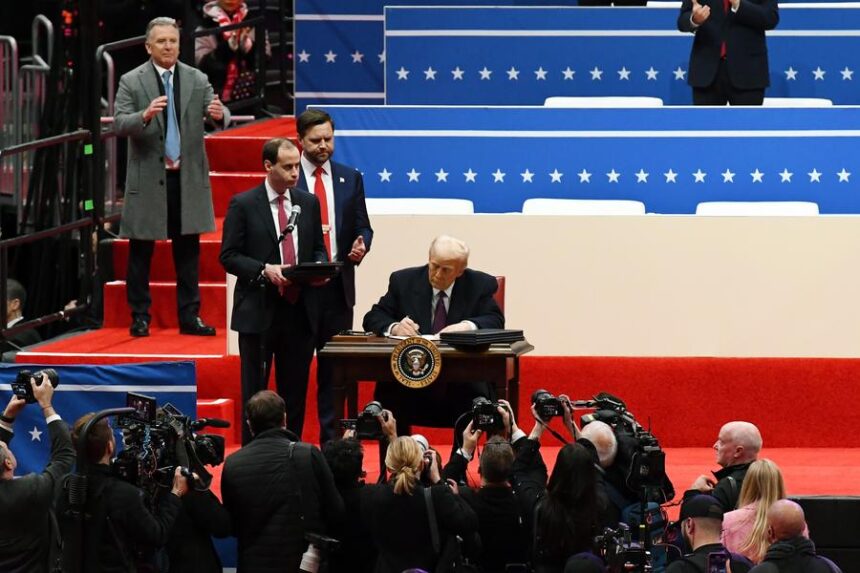As U.S. President Donald Trump approaches his first month in office, his administration has been marked by a series of headline-grabbing actions and remarks: the deportation of undocumented immigrants, massive federal government layoffs, frequent tariff threats, and the idea of “owning” Gaza.
Trump’s domestic policies have already sparked legal challenges and protests across the country, while his foreign policies have sent shockwaves around the globe. The starkly different evaluations of Trump’s policies by Republican and Democratic voters highlight the deepening political divide in American society.
Moreover, economists are increasingly concerned that Trump’s policies, particularly the push to deport undocumented immigrants and escalation of tariff threats, could reignite inflation, potentially jeopardizing a central pledge made during the campaign.
MAJOR MOVES
Upon taking office, Trump made the expulsion of illegal immigrants one of his top priorities. On Jan. 20, his inauguration day, he declared a national emergency at the southern border, calling for increased personnel, resources and physical barriers. He later directed the deployment of 1,500 additional U.S. troops to reinforce the southern border.
Trump also ordered the detention and deportation of individuals violating federal or state laws and swiftly removing all illegal entrants. The White House reported that over 8,000 illegal immigrants had been arrested in the first two weeks.
Another key agenda was pushing for major reforms of federal government agencies. On his inauguration day, Trump established an advisory committee called the “Department of Government Efficiency (DOGE),” led by billionaire Elon Musk, claiming it would significantly reduce federal spending.
DOGE has gained access to key departments’ information, including the Treasury and Defense Departments, and recently attempted to access personal tax data from the Internal Revenue Service. The U.S. Agency for International Development and the Consumer Financial Protection Bureau were among the key targets for cuts.
The Trump administration is pushing for large-scale workforce reductions in the federal government. On the one hand, it is offering a “buyout” plan to federal employees, providing eight months of salary as compensation to encourage voluntary resignations. On the other hand, it has begun laying off a significant number of probationary employees. More than 75,000 have agreed to accept the “buyout” plan, and over 10,000 have been dismissed.
Tariff news was continuous. On Feb. 1, Trump announced 25 percent tariffs on goods from Mexico and Canada, and 10 percent tariffs on goods from China. He then paused the tariffs on Mexico and Canada for one month. On Feb. 10, Trump raised tariffs on aluminum from 10 percent to 25 percent and ended exemptions and exclusions for steel and aluminum tariffs. On Feb. 13, he instructed relevant departments to determine necessary “reciprocal tariffs” on countries that impose tariffs on the United States. On Tuesday, Trump said tariffs of around 25 percent would be imposed on automotive, pharmaceutical and semiconductor industries.
On foreign policy, Trump continued his withdrawal from international agreements and made numerous statements that shook the world. After taking office, he quickly withdrew from the Paris Agreement and the World Health Organization. He threatened to “take back” the Panama Canal and renamed the Gulf of Mexico to the “Gulf of America.”
He also repeatedly stated that Canada should become the 51st state of the United States and recently threatened to “take over” Gaza. Arab League Secretary-General Ahmed Aboul-Gheit later said that the U.S. proposal on Gaza has been firmly rejected by Arab countries.
Additionally, Trump had phone calls with the presidents of Russia and Ukraine, catching European allies off guard. The extensive high-level talks between senior U.S. and Russian officials in Saudi Arabia on Tuesday has further unsettled the European countries and Ukraine, as the talks excluded both Europe and Ukraine.
“At every step in his second term, Mr. Trump is demonstrating how unbound he is from prior restraints, dramatically remaking both domestic and foreign policy at a scale that has little parallel,” The New York Times wrote. “He’s trying to do much more, much faster and going it alone in a way that he didn’t in his first term,” said National Public Radio (NPR).
“Trump has broadened executive authority more than any other recent president. He is testing the limits of legal authority,” Brookings Institution Senior Fellow Darrell West told Xinhua.
MIXED REACTIONS
As the White House touts Trump’s “extraordinary action to usher in a new Golden Age of America,” several Trump administration policies have sparked legal lawsuits and protests across the country, and the actual implementation remains to be seen.
So far, such moves as ending “birthright citizenship,” appointing Musk to lead DOGE, implementing the “buyout” plan to force federal employees to resign, and firing inspectors general without prior notice to Congress have all triggered legal challenges.
Recently, protests have erupted outside several federal agencies, opposing the “hostile takeover” of the federal government. On Monday, President’s Day, Democratic protests took place across the country, opposing Trump and Musk’s policies.
When evaluating the Trump administration’s policies, voters from the two parties often have vastly different views.
Ron Belsen, a Republican in the U.S. state of Pennsylvania, told Xinhua that he agreed with the cuts to “frivolous foreign aid.” Myrtle O’Hara, a Republican in the state of New Jersey, told Xinhua that Trump is “keeping his promises” on immigration.
Greg Cusack, a former member of the Iowa House of Representatives and a longtime Democrat, believes otherwise. He told Xinhua that the damage unleashed on civil servants and government agencies “is immense and, perhaps, truly immeasurable.”
A recent survey released by the Pew Research Center shows that in less than a month after Trump’s return to the White House, the American public is divided on the impact his administration will have on the federal government: 41 percent believe the Trump administration will improve the functioning of the federal government, while 42 percent think it will make things worse. Seventy-six percent of Republicans believe Trump will improve the federal government’s operations, while 78 percent of Democrats believe he will only make the situation worse.
Trump’s foreign policy is reverberating worldwide. Richard Haass, president emeritus of the Council on Foreign Relations and director of policy planning under former President George W. Bush, told NPR that Trump is operating as though the United States has “special rights” to decide the fate of others.
Noting that it’s a big mistake to alienate U.S. allies, Haass said the United States could end up with less influence.
PROMISES FULFILLED?
In early December, during his first interview after winning the election, Trump said he credited his victory to Americans’ anger over immigration and inflation. He had repeatedly promised during his campaign to deport illegal immigrants and reduce prices.
After his inauguration, Trump described immigration as his top priority and introduced several related measures. However, in the executive order regarding inflation, he simply ordered “the heads of all executive departments and agencies to deliver emergency price relief, consistent with applicable law, to the American people,” without including specific measures to lower prices.
With the ongoing deportation of illegal immigrants and escalating tariff threats, economists worry that Trump’s policies could trigger a resurgence of inflation.
Recent data released by the Labor Department shows that the Consumer Price Index (CPI) in January rose by 3.0 percent year on year, up from 2.7 percent in November and 2.9 percent in December. Excluding the volatile food and energy prices, the core CPI rose 3.3 percent, up from 3.2 percent in December. The latest data is well above the Federal Reserve’s long-term inflation target of 2 percent.
“With Trump adding tariffs to the mix, there is very little chance that the rate will drop to the 2 percent target,” Gary Clyde Hufbauer, a nonresident senior fellow at the Peterson Institute for International Economics, told Xinhua. “My guess is that inflation will persist in the range of 3.0 percent to 3.8 percent for the next 6 months,” he said.
Dean Baker, a senior economist at the Center for Economic and Policy Research, told Xinhua that it “seems likely” that food inflation will continue to rise for two reasons.
Due to the Trump administration’s inadequate response to the bird flu outbreak, it is likely to continue spreading, which means the current egg shortage and high prices will persist, he explained.
Also, if Trump follows through on his promise to deport a large number of illegal migrant workers, it will drive up the prices of agricultural products and processed foods. Migrant workers make up a significant portion of the labor force in these industries, added Baker.
“Since Trump promised to bring costs down, and that was so important for him in the election, the persistence of inflation will hurt him and make it difficult to deliver on some of his key objectives,” Darrell West said.
Trump’s statements also highlight the importance of inflation. After the CPI data was released, Trump quickly posted on social media: “BIDEN INFLATION UP!”
Given that Trump was inaugurated on Jan. 20, the January CPI data does not reflect an entire month of his presidency.
“For the time being, Trump supporters will attribute inflated prices to the (Joe) Biden administration,” Clay Ramsay, a researcher at the Center for International and Security Studies at the University of Maryland, told Xinhua. “By summer, it will be hard to keep up that attitude.” (Matthew Rusling contributed to the report)
(Video reporters: Xiong Maoling, Hu Yousong, Deng Xianlai; Video editors: Hong Ling, Wei Yin, Liu Xiaorui, Hong Liang)■













